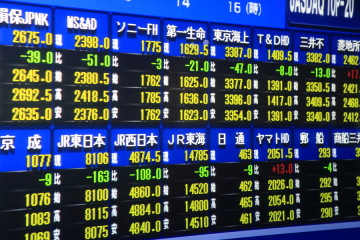Asian Futures Signal More Stock Gains to Come With Oil Near $50

©2015 Bloomberg News
NVXE1Y6KLVRE
(Bloomberg) — It’s the rally that just keeps on giving.
Asian index futures foreshadowed another day of gains for the region’s stocks, with global equities on track for their best week since 2012 amid a bounce back in oil. No such luck for the dollar, which is languishing near a three-week low versus major peers after minutes of the Federal Reserve’s last meeting showed officials discussed how the currency’s strength was damping inflation and that growing global risks spurred them to stand pat on hiking interest rates in September. Malaysian ringgit forwards soared.
“The latest minutes clearly suggest that international factors are an unusually large determinant of U.S. policy deliberations,” Matthew Sherwood, head of investment strategy at Perpetual Ltd. in Sydney, which manages about $21 billion, wrote in an e-mail to clients. “This, combined with the weak September U.S. nonfarm payrolls report indicate that the hurdle for a U.S. rate hike has increased further, which was music to the ears of investors.”
Global stocks have staged a comeback following their worst quarter since 2011, surging 3.9 percent this week as signs of an uneven recovery in the U.S. job market keeps bets the Fed will raise rates this year below 40 percent. While U.S. policy makers noted continued improvement in the American economy, according to the Fed minutes released Thursday, China’s slowdown was flagged as having a potential spillover effect to the global economy. Oil’s rebound has also underpinned equity gains this week, amid speculation demand is picking up and as tensions in the Middle East increased.
Stocks
Futures on the Standard & Poor’s 500 Index dropped 0.1 percent to 2,005 by 8:41 a.m. in Tokyo, after the index rose a second day in New York, adding 0.8 percent to close above 2,000 points for the first time since Aug. 20. Energy producers drove the advance, climbing 1.9 percent as West Texas Intermediate crude briefly rose to as high as $50.07 a barrel.
The S&P/ASX 200 Index gained 1.2 percent in Sydney, set for a weekly climb of 4.4 percent, the most since 2011. New Zealand’s S&P/NZX 50 Index, the first major stock index to start trading each day in the Asian region, climbed 0.7 percent, headed for a 1.3 percent advance in the week.
Nikkei 225 Stock Average futures were bid up 0.8 percent in the Osaka pre-market, for 18,250.
Futures on the Hang Seng and Hang Seng China Enterprises indexes in Hong Kong rose at least 0.3 percent. Chinese markets resumed trading Thursday for the first time in a week, with the Shanghai Composite Index’s 3 percent advance underwhelming investors who had seen the Enterprises gauge, which tracks mainland Chinese stocks listed in Hong Kong, climb 11 percent in the period China was out.
While FTSE China A50 Index futures rose 0.8 percent in recent trade, the biggest U.S. exchange-traded fund tracking Chinese shares fell Thursday in New York, dropping 1.3 percent from a seven-week high as slowdown concerns reasserted themselves.
Markets in Taiwan and South Korea are closed for holidays Friday, with Australian home loan data due and the Philippines due to report on exports. Thailand will update on its foreign reserves.
Currencies
The Bloomberg Dollar Spot Index dropped another 0.1 percent Friday, extending last session’s 0.4 percent decline to put it on track for a weekly loss of 1.1 percent, its worst five days since mid-June. The euro added 0.1 percent to $1.1287 and is up 0.6 percent in a second week of gains.
The Fed noted that the greenback had “strongly appreciated” against emerging market currencies and those of commodity exporters, according to the minutes. An appreciating dollar tends to restrain the U.S. economy by making American products more expensive abroad, while keeping down inflation by making imports less costly.
Odds of the Fed boosting rates from near zero at their meeting this month are at 10 percent, according to Fed funds futures, while the chance of a move in December is holding at 38.8 percent, down from 59.9 percent a month ago. Many economists, however, are heeding comments from Fed officials including Chair Janet Yellen, who have touted the possibility of a rate rise before the year is out since the Sept. 17 decision.
Australia’s dollar climbed an eighth day, set for its best week since September 2013, while the rebound in oil fueled a 2.1 percent surge in one-month non-deliverable forwards tracking the ringgit. Malaysia is the Asian region’s only major oil exporter and the currency tends to move in line with crude prices.
Emerging-market currencies are leading gains against the dollar this week as the prospect of the Fed being on hold until next year bolsters riskier assets. One-month NDFs on the Indonesian rupiah gained 1.2 percent in early trading, with the currency headed for a 5.5 percent surge in the week, the best performance among its Asian peers.
Despite an index of developing-nation currencies rising to an almost two-month high, most analysts are not on board with the rally. All 23 emerging-market currencies tracked by Bloomberg are projected to weaken versus the greenback by the first quarter, and Credit Suisse Group AG to Pacific Investment Management Co. say the current rally will prove fleeting.
–With assistance from Jeremy Herron in New York.
To contact the reporter on this story: Emma O’Brien in Wellington at eobrien6@bloomberg.net To contact the editors responsible for this story: Emma O’Brien at eobrien6@bloomberg.net John McCluskey







No Comment